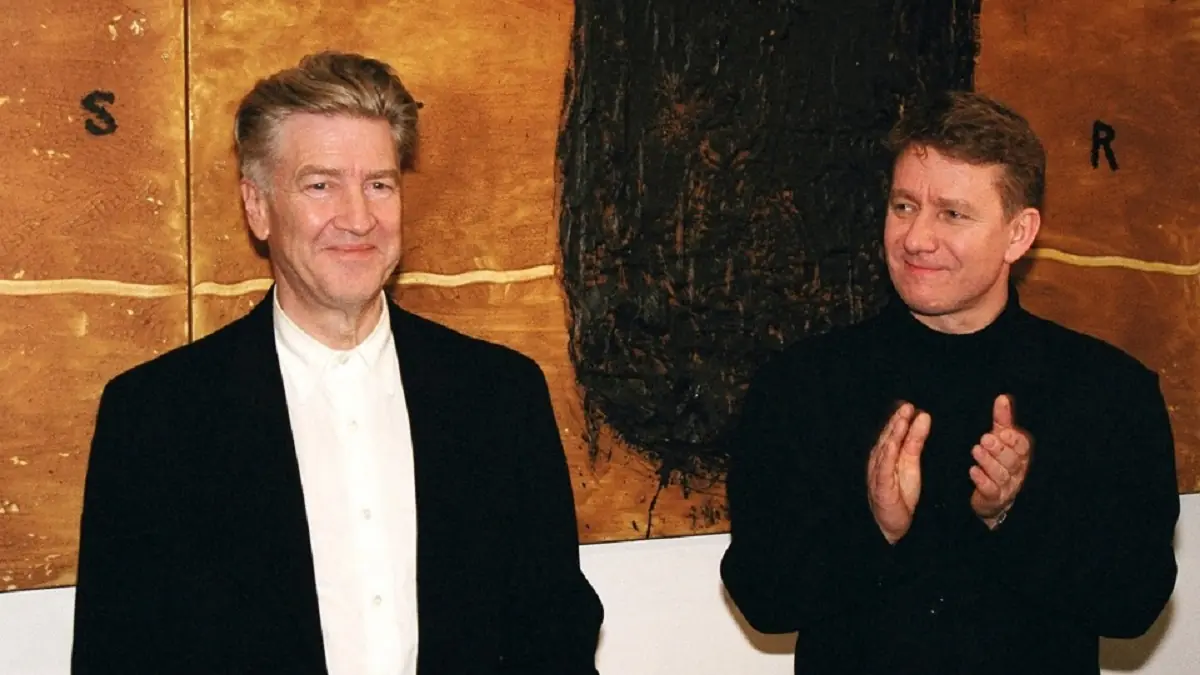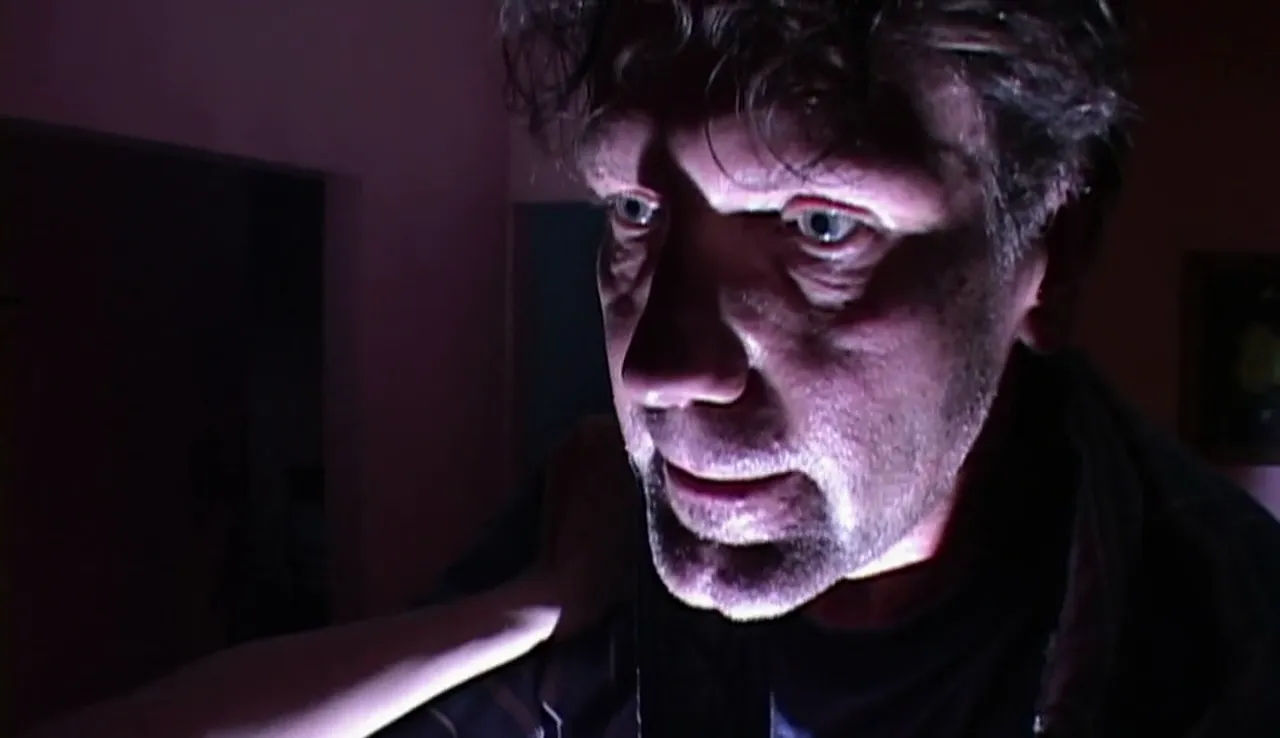INLAND EMPIRE Explained: A Labyrinth with No Exit

Of course, between 2003 and 2006, Lynch was not solely occupied with matters related to Transcendental Meditation. At the end of 2003, he visited Łódź and participated in the Camerimage Festival, where he received an order from the then-Minister of Culture for his contribution to Polish culture, which—considering his artistic profile—was more of a courtesy gesture than a carefully thought-out decision.
Between Łódź and Los Angeles
It is also worth mentioning that, parallel to the festival, an exhibition of Lynch’s works and photographs was organized in Łódź. The exhibition included ten of the director’s paintings delivered to Poland from Los Angeles and a series of thirty black-and-white photographs taken by Lynch in the deserted factories of Łódź. The American filmmaker recalled that during his explorations, he once again felt the desire to direct Ronnie Rocket, as the settings he found in Poland seemed to be drawn straight from his imagination. Ultimately, nothing came of it, but the visit to Poland turned out to be more than an incidental event. Łódź and Polish actors would soon prove to be an extremely important element of Inland Empire.

At the turn of 2003 and 2004, Lynch was seeking the necessary funds to bring to life a project titled Snootworld. The film was intended to be a feature-length animated movie designed primarily using computer animation techniques. Unfortunately, little is known about its plot. Peggy Reavey, a friend of Lynch, described it in an interview as Lynch’s version of Harry Potter. Michael J. Anderson, meanwhile, recalled that in one conversation, Lynch revealed to him that the film was meant to be a family movie in the spirit of The Straight Story, set in a town where there were only two names—one for women and one for men. Snootworld failed to garner interest from any producer, and Lynch quickly decided to abandon the project as he began work on Inland Empire in 2003.
The production of Inland Empire was made possible largely through the director’s private financial investment and funds from sponsors who did not claim any rights to influence the final shape of the film or profit from its subsequent distribution. The remaining amount was provided by the director’s longtime partner, Studio Canal, with whom he had previously worked on Mulholland Drive. This form of financing gave Lynch complete creative freedom regarding the organization of the shoot and the direction the production would take—a process that turned out to be unconventional even by Lynch’s standards.

Inland Empire never had a script. Each scene was created by Lynch on the spot, during the consecutive shooting days. The foundation for the project was an over-hour-long monologue written specifically for Laura Dern. Portions of it can be heard in the film when Dern’s character climbs the stairs of a dark tenement building and begins recounting her story to a man sitting behind a desk.
Filming took place mainly in Los Angeles and Łódź, which Lynch visited again in 2006. In addition to a group of Polish actors, the cast also included performers from the Zalewski Circus troupe. Inland Empire was the first Lynch film to be shot entirely using a digital camera (Sony DSR-PD150). The director stated that if he were to create another production, he had no intention of returning to film stock. Initially, the movie was slated to be completed by May 2006, which would have allowed it to premiere in the Cannes environment, generally favorable to Lynch. Unfortunately, this plan fell through, as during post-production, Lynch’s wife and editor, Mary Sweeney, moved out of his house and took their young son with her. The reason for the collapse of yet another marriage was, once again, an affair—this time with Emily Stofle, a much younger woman Lynch had met during a photo session. Stofle also appeared in the cast of Inland Empire (interestingly, as a woman of ill repute). Lynch was forced to edit the material himself. Ultimately, Inland Empire premiered in 2006 at the Venice Film Festival, where the director received a lifetime achievement award.

Polish Poem
What exactly is Inland Empire? Is it still a film, or perhaps an art installation designed to explore the boundaries of a medium standing at the threshold separating the era of film stock from that of digital recording, which was becoming increasingly accessible to the average person? Is Inland Empire merely a collection of loosely connected scenes, or a multi-layered puzzle whose meanings spread like a vine—without a logical structure organizing the whole, but nonetheless with a precise intent for the benefit of the overall piece? The answer to this question, unsurprisingly in the context of Lynch’s filmography, is anything but simple. More than that, it resides solely in the eye and mind of the viewer confronting an image that, more than any other Lynch film, is geared toward an experience, rather than an attempt to intellectually grasp the intricate paths of its narrative.

Inland Empire is, in a sense, a meta-film. However, it does not aim for a simple invitation into the world hidden behind the curtain, nor does it seek to expose the artificial nature of the medium by pointing directly at the apparatus responsible for recording sound and image. Lynch goes much further. None of the actors appearing on the film’s set held a script in their hands, as no such script ever existed. None of them had any idea who their characters truly were or what defining traits they should embody. The story presented by the director intertwines multiple realities, within which the characters do not merely behave differently—they completely change their identities. The viewer cannot be sure to which order the scenes being shown belong, nor were the actors themselves. Just as we begin to feel certain that we are watching the reality of On High in Blue Tomorrows—the production in which Laura Dern’s character and the one played by Justin Theroux are to star—something or someone appears within the frame that does not fit into our conception at all.

Symbolically, this is best illustrated by the scene where Dern and Theroux, hidden under a blanket, are having sex. The woman keeps talking, but suddenly her monologue turns into a desperate scream. Until that moment, everything suggests that we are witnessing a scene from On High in Blue Tomorrows, meaning that Sue and Billy are in bed. But Dern screams that her name is Nikki—the name of the actress playing Sue. Theroux is initially confused, then starts laughing. Behind the door, Nikki’s jealous husband appears, wearing a green vest previously mentioned by the rabbits imprisoned in one of the rooms of the vast Hollywood mansion. Is this still Nikki’s husband? Or is it the nameless evil lurking beyond the threshold of the rabbits’ room? Is Nikki truly Nikki? Billy truly Billy? Or is it all merely a scene pulled from yet another film, part of a script? We do not know.
Inland Empire continually undermines and ruins the worlds it builds during the viewing experience. It constantly reveals that cinema is nothing but an illusion—the very idea expressed by the MC in the Silencio club from Mulholland Drive. In Lynch’s earlier film, the protagonist ultimately managed to reclaim her identity, though ending the cinematic dream and returning to reality proved to have tragic consequences.

The unmasking of the medium during the Silencio scene was a singular operation, functioning as an exit from the labyrinth. In Inland Empire, escaping the tangled corridors is impossible because we lack a reference point to definitively determine that any exit—or entrance—exists at all. The reality of On High in Blue Tomorrows and Vier Sieben (the cursed film that served as the basis for On High…), Nikki’s world, the character played by Karolina Gruszka, the Rabbits’ room, and a series of scenes connecting these realities to create spaces that belong to none of them form a tangle so dense and wild that no light penetrates its interior. Without such light, there is no guiding thread to follow toward solving the puzzle.
The condition for enjoying the journey through Inland Empire is accepting this state of affairs and, consequently, abandoning the instinctive urge to organize the film’s imagery into a coherent whole via a specific interpretive key. The labyrinth can only be exited by rising above it, and this is precisely what happens in the film’s finale. Accompanied by the angelic voice of Chrysta Bell performing Polish Poem, Laura Dern meets Karolina Gruszka. Without words, in complete mutual understanding, she tenderly kisses her on the lips, thus ending the nightmare experienced by both women.

